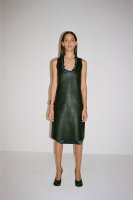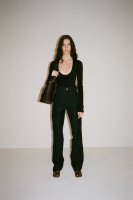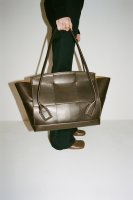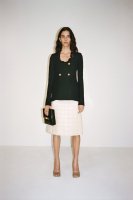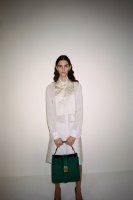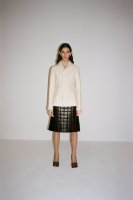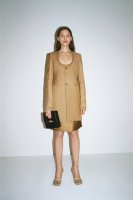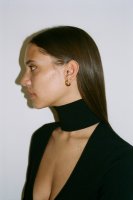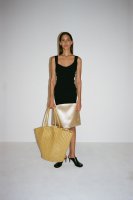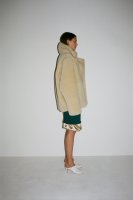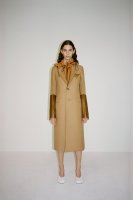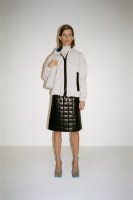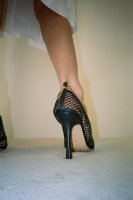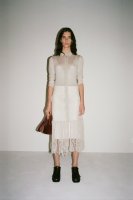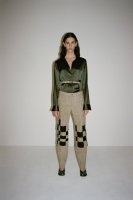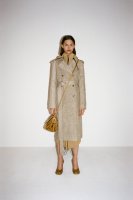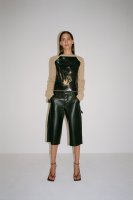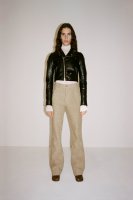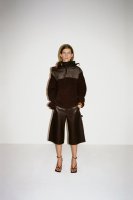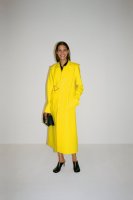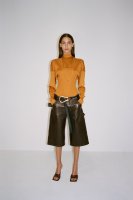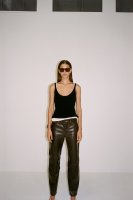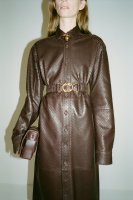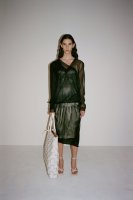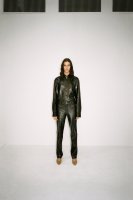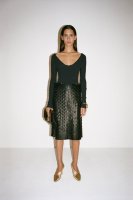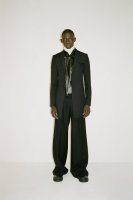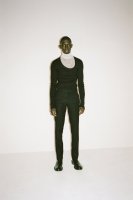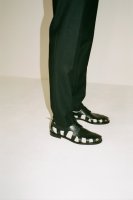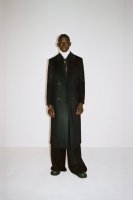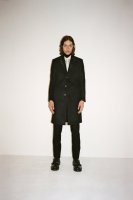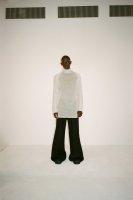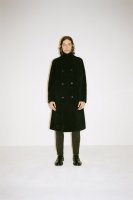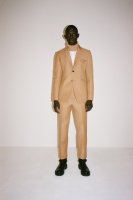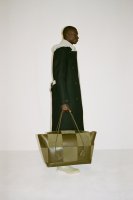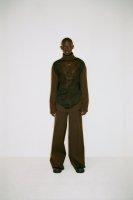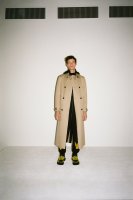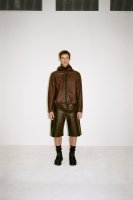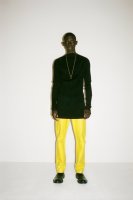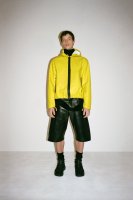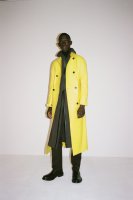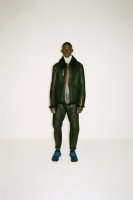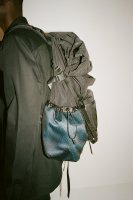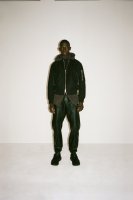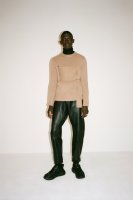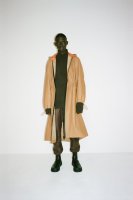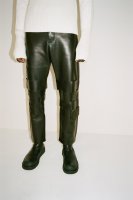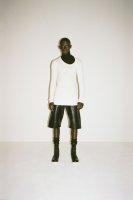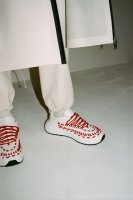Pictures are up for the BOTTEGA VENETA PRE-FALL 2019 SHOW
Enjoy.
MILAN,DECEMBER 12, 2018
by SARAH MOWER
Before we start, let’s do the introductions: Ladies and gentlemen, this is Daniel Lee, whom you might call a known-unknown, a 32-year-old English designer who came to Bottega Veneta from Celine in July, replacing Tomas Maier. It’s the Celine part of Lee’s provenance that is salient—if that’s the right word—to the frisson of anticipation about him felt by the legions of women who are still living with post–Phoebe Philo fashion disenfranchisement. Could this protégé of the great woman have learned her touch, her rigor, her practicality, and her covert wit? Or—since goodness knows, there are quadrillions of duplicated Philo-Celine clothes in the world—will Lee strike out and do something uniquely his own?
That’s a lot of expectation to put on the shoulders of a young designer, and Lee must certainly feel it. He didn’t seem thrown by it, though, as he walked around the showroom where his first Pre-Fall women’s, men’s, and accessories collections were being given a soft launch before the Fall runway. The first words from his mouth were reassuringly down-to-earth and uplifting at the same time: “I like real clothes. I think there’s a need for a return to elegance and sophistication.” He said he has been looking about the streets of Milan and thinking about how Italian women dress. “I started thinking about film stars like Monica Vitti, and about modern women like Franca and Carla Sozzani.”
Lee has lived in New York, London, and Paris since he graduated in the class of 2011 from Central Saint Martins’s M.A. degree course, the fashion boot camp then run by the late professor Louise Wilson (where two of his peers were the designers behind Marques’Almeida). This is his first job in Italy—and his first viewpoint on the culture of northern Italian dress codes, which is home territory well-patrolled by Prada, Max Mara, Salvatore Ferragamo, Ermenegildo Zegna, et al. What can be new? A temptation for an outsider might be to fall into over-reverent pastiche or satire. But at first impression, there was something refreshingly modern and respectful, without being timid, in Lee’s treatment of the canon of black blazers, beige overcoats, silk blouses, gold jewelry, and pumps. “I like structure,” he said. “There has to be quality—well, I came from somewhere that had great fabrics. And, of course, I’ve had to think about leather. Bottega Veneta is based on leather.”
A tailored black jacket had a scoop neckline carved out with a raw edge and artily beaten gold buttons. A camel coat had a deep silk “lining” sleeve cuff and a “handkerchief square” detail transferred from the inside of a man’s pocket. There were fluid, golden caramel blouses and well-cut pants. The sort of clever, low-intervention details—like the knotted straps on a set of satin slip dresses—that turn the wearable generic into something quirkily desirable.
If anything can be gleaned of character from a pre-collection, some of the echoes in this one seemed to place Lee among his fashion generation’s loves. There was a touch of Martin Margiela and Helmut Lang, and even a hint of Tom Ford’s ’90s Gucci years (satin blouses, slinky black jersey dresses).
The menswear, Lee said, “is just what I like to wear!” And besides the suiting, considerably more sporty than the women’s. There were leather jackets with articulated elbows and motocross sweatpants with articulated knees. Oversize gray double-face cashmere shirts did the job of replacing tailored jackets.
The tour ended with the accessories. Lee had taken the jewel in the crown of Bottega—the famous woven leather intrecciato technique—and supersized it. “I exploded it,” he said, laughing. Result: The chunky pattern will look distinctive from across a street. As will the curiously bulbous square-toe pumps and boots, also latticeworked in leather. A bright turquoise pair of ankle boots had all the head-turning vibrancy of an It thing of the season.
Is this a star-is-born scenario? A Philo replacement in the making? Too soon to call. When women walk in the Fall show in February, we’ll see more. But from what was in evidence in this showroom, after only a couple of months’ work, there are substantial, well-made clothes here that would make a customer want to reach for them in a shop. And just enough borderline ridiculousness in the accessories to turn that bourgeois look into proper fashion fun.
article courtesy of: vogue.com
Enjoy.
MILAN,DECEMBER 12, 2018
by SARAH MOWER
Before we start, let’s do the introductions: Ladies and gentlemen, this is Daniel Lee, whom you might call a known-unknown, a 32-year-old English designer who came to Bottega Veneta from Celine in July, replacing Tomas Maier. It’s the Celine part of Lee’s provenance that is salient—if that’s the right word—to the frisson of anticipation about him felt by the legions of women who are still living with post–Phoebe Philo fashion disenfranchisement. Could this protégé of the great woman have learned her touch, her rigor, her practicality, and her covert wit? Or—since goodness knows, there are quadrillions of duplicated Philo-Celine clothes in the world—will Lee strike out and do something uniquely his own?
That’s a lot of expectation to put on the shoulders of a young designer, and Lee must certainly feel it. He didn’t seem thrown by it, though, as he walked around the showroom where his first Pre-Fall women’s, men’s, and accessories collections were being given a soft launch before the Fall runway. The first words from his mouth were reassuringly down-to-earth and uplifting at the same time: “I like real clothes. I think there’s a need for a return to elegance and sophistication.” He said he has been looking about the streets of Milan and thinking about how Italian women dress. “I started thinking about film stars like Monica Vitti, and about modern women like Franca and Carla Sozzani.”
Lee has lived in New York, London, and Paris since he graduated in the class of 2011 from Central Saint Martins’s M.A. degree course, the fashion boot camp then run by the late professor Louise Wilson (where two of his peers were the designers behind Marques’Almeida). This is his first job in Italy—and his first viewpoint on the culture of northern Italian dress codes, which is home territory well-patrolled by Prada, Max Mara, Salvatore Ferragamo, Ermenegildo Zegna, et al. What can be new? A temptation for an outsider might be to fall into over-reverent pastiche or satire. But at first impression, there was something refreshingly modern and respectful, without being timid, in Lee’s treatment of the canon of black blazers, beige overcoats, silk blouses, gold jewelry, and pumps. “I like structure,” he said. “There has to be quality—well, I came from somewhere that had great fabrics. And, of course, I’ve had to think about leather. Bottega Veneta is based on leather.”
A tailored black jacket had a scoop neckline carved out with a raw edge and artily beaten gold buttons. A camel coat had a deep silk “lining” sleeve cuff and a “handkerchief square” detail transferred from the inside of a man’s pocket. There were fluid, golden caramel blouses and well-cut pants. The sort of clever, low-intervention details—like the knotted straps on a set of satin slip dresses—that turn the wearable generic into something quirkily desirable.
If anything can be gleaned of character from a pre-collection, some of the echoes in this one seemed to place Lee among his fashion generation’s loves. There was a touch of Martin Margiela and Helmut Lang, and even a hint of Tom Ford’s ’90s Gucci years (satin blouses, slinky black jersey dresses).
The menswear, Lee said, “is just what I like to wear!” And besides the suiting, considerably more sporty than the women’s. There were leather jackets with articulated elbows and motocross sweatpants with articulated knees. Oversize gray double-face cashmere shirts did the job of replacing tailored jackets.
The tour ended with the accessories. Lee had taken the jewel in the crown of Bottega—the famous woven leather intrecciato technique—and supersized it. “I exploded it,” he said, laughing. Result: The chunky pattern will look distinctive from across a street. As will the curiously bulbous square-toe pumps and boots, also latticeworked in leather. A bright turquoise pair of ankle boots had all the head-turning vibrancy of an It thing of the season.
Is this a star-is-born scenario? A Philo replacement in the making? Too soon to call. When women walk in the Fall show in February, we’ll see more. But from what was in evidence in this showroom, after only a couple of months’ work, there are substantial, well-made clothes here that would make a customer want to reach for them in a shop. And just enough borderline ridiculousness in the accessories to turn that bourgeois look into proper fashion fun.
article courtesy of: vogue.com

